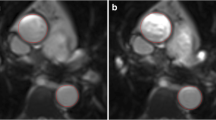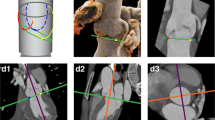Abstract
Background
Bicuspid aortic valve disease (BAV) is increasingly recognized as a disease of the entire proximal aorta including both valvular and vascular complications. The aim of our study was to assess the dimensions of the thoracic aorta using MRI in a broad spectrum of BAV and tricuspid aortic valve disease (TAV) and to define the prevalence of the dilatation of the ascending aorta (AA) ≥4.5 cm in severe BAV disease.
Methods and results
MRI studies were performed on a 1.5 T scanner in a total of 195 consecutive patients with aortic valve disease. Eighty-four aortic valves were classified as BAV and 103 as TAV. In 8 patients, classification of the aortic valve was not possible due to poor image quality. Mean diameters of the AA were significantly greater in BAV compared to TAV (4.39 ± 0.85 Vs. 3.55 ± 0.47 cm, P < 0.0001), whereas no differences were observed in the mean diameters of the aortic arch. Diameters of the descending aorta were slightly smaller in BAV compared to TAV (2.45 ± 0.43 Vs. 2.58 ± 0.31 cm, P < 0.05). In BAV, AA dilatation was independent of the severity of valve dysfunction. In TAV, aortic regurgitation but not stenosis correlated weakly with AA dilatation. Prevalence of AA dilatation ≥4.5 cm in BAV with severe aortic stenosis and regurgitation was 38% and 41%, respectively.
Conclusion
Dilatation of the proximal aorta is a frequent finding in BAV and independent of the severity of valve dysfunction. With respect to the high prevalence of AA dilatation ≥4.5 cm in BAV with severe valve dysfunction, careful assessment of the dimensions of the AA is crucial to identify patients in whom concomitant AA replacement is indicated according to current guidelines.





Similar content being viewed by others
References
Bauer M, Pasic M, Meyer R, Goetze N, Bauer U, Siniawski H, Hetzer R (2002) Morphometric analysis of aortic media in patients with bicuspid and tricuspid aortic valve. Ann Thorac Surg 74:58–62
Bonow RO, Carabello BA, Kanu C, de Leon AC Jr., Faxon DP, Freed MD, Gaasch WH, Lytle BW, Nishimura RA, O’Gara PT, O’Rourke RA, Otto CM, Shah PM, Shanewise JS, Smith SC Jr., Jacobs AK, Adams CD, Anderson JL, Antman EM, Faxon DP, Fuster V, Halperin JL, Hiratzka LF, Hunt SA, Lytle BW, Nishimura R, Page RL, Riegel B (2006) ACC/AHA 2006 guidelines for the management of patients with valvular heart disease. Circulation 114:450–527
Borger MA, Preston M, Ivanov J, Fedak PW, Davierwala P, Armstrong S, David TE (2004) Should the ascending aorta be replaced more frequently in patients with bicuspid aortic valve disease? J Thorac Cardiovasc Surg 128:677–683
Cecconi M, Manfrin M, Moraca A, Zanoli R, Colonna PL, Bettuzzi MG, Moretti S, Gabrielli D, Perna GP (2005) Aortic dimensions in patients with bicuspid aortic valve without significant valve dysfunction. Am J Cardiol 95:292–294
Chatzimavroudis GP, Oshinski JN, Franch RH, Pettigrew RI, Walker PG, Yoganathan AP (1998) Quantification of the aortic regurgitant volume with magnetic resonance phase velocity mapping: a clinical investigation of the importance of imaging slice location. J Heart Valve Dis 7:94–101
Debl K, Djavidani B, Seitz J, Nitz W, Schmid FX, Muders F, Buchner S, Feuerbach S, Riegger G, Luchner A (2005) Planimetry of aortic valve area in aortic stenosis by magnetic resonance imaging. Invest Radiol 40:631–636
Debl K, Djavidani B, Buchner S, Heinicke N, Fredersdorf S, Haimerl J, Poschenrieder F, Feuerbach S, Riegger GA, Luchner A (2008) Assessment of the anatomic regurgitant orifice in aortic regurgitation: a clinical magnetic resonance imaging study. Heart 94:e8. Epub 2007 Aug 8
Fedak PW, Verma S, David TE, Leask RL, Weisel RD, Butany J (2002) Clinical and pathophysiological implications of a bicuspid aortic valve. Circulation 106:900–904
Fedak PW, de Sa MP, Verma S, Nili N, Kazemian P, Butany J, Strauss BH, Weisel RD, David TE (2003) Vascular matrix remodeling in patients with bicuspid aortic valve malformations: implications for aortic dilatation. J Thorac Cardiovasc Surg 126:797–806
Friedrich MG, Schulz-Menger J, Poetsch T, Pilz B, Uhlich F, Dietz R (2002) Quantification of valvular aortic stenosis by magnetic resonance imaging. Am Heart J 144:329–334
Hombach V, Merkle N, Kestler HA, Torzewski J, Kochs M, Marx N, Nusser T, Burgstahler C, Rasche V, Bernhardt P, Kunze M, Wöhrle J (2008) Characterization of patients with acute chest pain using cardiac magnetic resonance imaging. Clin Res Cardiol 97(10):760–767
John AS, Dill T, Brandt RR, Rau M, Ricken W, Bachmann G, Hamm CW (2003) Magnetic resonance to assess the aortic valve area in aortic stenosis: how does it compare to current diagnostic standards?. J Am Coll Cardiol 42:519–526
Keane MG, Wiegers SE, Plappert T, Pochettino A, Bavaria JE, Sutton MG (2000) Bicuspid aortic valves are associated with aortic dilatation out of proportion to coexistent valvular lesions. Circulation 102(Suppl III):III-35–III-39
Koeth O, Mark B, Kilkowski A, Layer G, Cornelius B, Kouraki K, Bauer T, Zahn R, Senges J, Zeymer U (2008) Clinical, angiographic and cardiovascular magnetic resonance findings in consecutive patients with Takotsubo cardiomyopathy. Clin Res Cardiol 97:623–627
Krombach GA, Kuhl H, Bucker A, Mahnken AH, Spuntrup E, Lipke C, Schroder J, Gunther RW (2004) Cine MR imaging of heart valve dysfunction with segmented true fast imaging with steady state free precession. J Magn Reson Imaging 19:59–67
Kupfahl C, Honold M, Meinhardt G, Vogelsberg H, Wagner A, Mahrholdt H, Sechtem U (2004) Evaluation of aortic stenosis by cardiovascular magnetic resonance imaging: comparison with established routine clinical techniques. Heart 90:893–901
Lewin MB, Otto CM (2005) The bicuspid aortic valve: adverse outcomes from infancy to old age. Circulation 111:832–834
Mathias Bechtel JF, Noack F, Sayk F, Erasmi AW, Bartels C, Sievers HH (2003) Histopathological grading of ascending aortic aneurysm: comparison of patients with bicuspid versus tricuspid aortic valve. J Heart Valve Dis 12:54–59
Morgan-Hughes GJ, Roobottom CA, Owens PE, Marshall AJ (2004) Dilatation of the aorta in pure, severe, bicuspid aortic valve stenosis. Am Heart J 147:736–740
Nistri S, Sorbo M, Basso C, Thiene G (2002) Bicuspid aortic valve abnormal aortic elastic properties. J Heart Valve Dis 11:369–374
Nistri SM, Sorbo MD, Marin M, Palisi M, Scognamiglio R, Thiene G (1999) Aortic root dilatation in young men with normally functioning bicuspid aortic valves. Heart 82:19–22
Niwa K, Perloff J, Bhuta SM, Laks H, Drinkwater DC, Child JS, Miner PD (2001) Structural abnormalities of great arterial walls in congenital heart disease. Circulation 103:393–400
Roberts WC, Ko JM (2005) Frequency of unicuspid, bicuspid and tricuspid aortic valves by decade in adults having aortic valve replacement for isolated aortic stenosis. Circulation 111:920–925
Scharhag J, Meyer T, Kindermann I, Schneider G, Urhausen A, Kindermann W (2006) Bicuspid aortic valve: evaluation of the ability to participate in competitive sports: case reports of two soccer players. Clin Res Cardiol 95:228–234
Schmid FX, Bielenberg K, Holmer S, Lehle K, Djavidani B, Prasser C, Wiesenack C, Birnbaum D (2004) Structural and biomolecular changes in aorta and pulmonary trunk of patients with aortic aneurysm and valve disease: implications for the Ross procedure. Eur J Cardiothorac Surg 25:748–753
Ward C (2000) Clinical significance of the bicuspid aortic valve. Heart 83:81–85
Yasuda H, Nakatani S, Stugaard M, Tsujita-Kuroda Y, Bando K, Kobayashi J, Yamagishi M, Kitakaze M, Kitamura S, Miyatake K (2003) Failure to prevent progressive dilation of ascending aorta by aortic valve replacement in patients with bicuspid aortic valve: comparison with tricuspid aortic valve. Circulation 108(Suppl 1):291–294
Conflict of interest
There are no conflicts of interest to disclose.
Author information
Authors and Affiliations
Corresponding author
Additional information
K. Debl and B. Djavidani contributed equally as first author
Rights and permissions
About this article
Cite this article
Debl, K., Djavidani, B., Buchner, S. et al. Dilatation of the ascending aorta in bicuspid aortic valve disease: a magnetic resonance imaging study. Clin Res Cardiol 98, 114–120 (2009). https://doi.org/10.1007/s00392-008-0731-0
Received:
Accepted:
Published:
Issue Date:
DOI: https://doi.org/10.1007/s00392-008-0731-0




